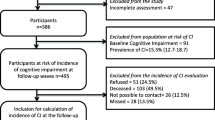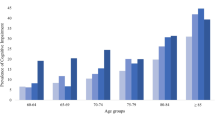Abstract
Data on cognitive impairment in the oldest old is reported comparing two different samples, one in Munich, Germany, and the other in the United States (Epidemiologic Catchment Area [ECA] study). In both studies the Mini Mental State Examination (MMSE) was used for assessing cognitive impairment. The Munich sample consisted of 402 and the ECA sample of 827 very old people aged 85 years and above. The results indicate that approximately 40% of each sample scored below 24 points in the MMSE indicating at least mild cognitive impairment. Severe cognitive impairment was found in 13.4% of the Munich and in 14.6% of the American sample. The prevalence of major depression was 1.4% in Munich and 2.0% in the ECA study, and dysthymia was found in 5.1% in the Munich and in 2.0% in the ECA sample aged 85 years and above. Persons living in institutions in both studies more frequently showed signs of cognitive impairment than those living in private households. The ECA sample, but not the Munich sample, showed a significantly higher prevalence of cognitive impairment for females and for the oldest age cohort above 90 years of age. Major depression was more frequent in Munich in persons living in institutions and in the ECA study among the oldest age cohort above 90 years of age. Dysthymia in both studies did not show any association with sociodemographic factors. Most of the excess comorbidity (cognitive impairment and depression) was observed among subjects with mild (and not with severe) cognitive impairment. Very similar prevalence rates were generally found not only for MMSE-based cognitive impairment, but contrary to our expectations, also for major depressive disorder. Out data partially confirm a further increase in the prevalence of cognitive impairment in very old age.
Similar content being viewed by others
References
American Psychiatric Association (1980) Diagnostic and statistical manual of mental disorders (DSM-III). American Psychiatric Press, Washington DC
American Psychiatric Association (1987) Diagostic and statistical manual of mental disorders (DSM-III-R), 3rd edn. American Psychiatric Press, Washington DC
Brayne C, Calloway P (1989) An epidemiological study of dementia in a rural population of elderly women. Br J Psychiatry 155:214–219
Campbell AJ, McCosh LM, Reinkew J, Allan BC (1983) Dementia in old age and the need for services. Age Ageing, 12:11–16
Clarke M, Jagger C, Anderson J, Battcock T, Kelly F, Campbell-Stern M (1991) The prevalence of dementia in a total population: a comparison of two screening instruments. Age Ageing 20:396–403
Cooper B, Sosna U (1983) Psychische Erkrankungen in der Alten-Bevölkerung. Eine epidemiologische Feldstudie in Mannheim. Nervenarzt 54:239–249
Cooper B, Bickel H (1989) Prävalenz und Inzidenz von Demenzerkrankungen in der Altenbevölkerung. Der Nervenarzt 60:472–482
Copeland JRM, McWilliam C, Dewey ME, Forshaw D, Shiwach R, Abed RT, Muthu MS, Wood N (1986a) The early recognition of dementia in the elderly: a preliminary communication about a longitudinal study using the GMS-AGECAT package (community version). Int J Geriatr Psychiatry 1:63–70
Copeland JRM, Dewey ME, Griffiths-Jones HM (1986b) Computerized psychiatric diagnostic system and case nomenclature for elderly subjects. GMS and AGECAT. Psychol Med 16:89–99
Copeland JRM, Dewey ME, Wood N, Searle R, Davidson IA, McWilliam C (1987a) Range of mental illness among the elderly in the community: prevalence in Liverpool using the GMS-AGECAT package. Br J Psychiatry 150:815–823
Copeland JRM, Gurland BJ, Dewey ME, Kelleher MJ, Smith AMR, Davidson IA (1987b) The distribution of dementia, depression and neurosis in elderly men and women in an urban community: assessed using the GMS-AGECAT package. Int J Geriatr Psychiatry 2:177–184
Copeland JRM, Gurland BJ, Dewey ME, Kelleher MJ, Smith AMR, Davidson IA (1987c) Is ther more dementia, depression and neurosis in New York? Br J Psychiatry 151:466–473
Cummings JL (1989) Dementia and depression: an evolving enigma. J Neuropsychiatry 3:236–242
Evans DA, Funkenstein HH, Albert MS, Scherr PA, Cook NR, Chown MJ, Hebert LE, Hennekens CH, Taylor JO (1989) Prevalence of Alzheimer's disease in a community population of older persons. J Am Med Assoc 262:2551–2556
Fichter MM, Meller I, Schröppel, H, Steinkirchner R (1995) Dementia and cognitive impairment in the oldest old in the community: prevalence and comorbidity. Br J Psychiatry 166:621–629
Fischer P, Simanyi M, Danielczyk W (1990) Depression in dementia of the Alzheimer type and in multi-infarct dementia. Am J Psychiatry 147:1484–1487
Folstein NF, Folstein SE, Hughes PR (1975) Mini Mental State: a practical method for grading the cognitive state of patients for the clinician. J Psychiatr Res 12:189–198
Griffiths RA, Good WR, Watson NP, O'Donnell HF, Fell PJ, Shakespeare JM (1987) Depression, dementia and disability in the elderly. Br J Psychiatry 150:482–493
Hachinski VV, Iliff LD, Zihlka E, DuBoulay GH, McAllister VL, Marshall J, Ross-Russell RE, Symon L (1975) Cerebral blood flow in dementia. Arch Neurol 32:632–637
Hagnell O, Lanke J, Rorsman B, Öjesjö L (1981) Does the incidence of age-psychosis decrease? A prospective, longitudinal study of a complete population investigated during the 25-year period 1947–1972: the Lundby study. Neuropsychobiology 7:201–211
Hamilton M (1976) 049 HAMD. Hamilton Depression Scale. In: Guy W (ed) ECDEU assessment manual for psychopharmacology (review edn) rockville, Maryland, pp 179–192
Helmchen H, Linden M (1993) The differentiation between depression and dementia in the very old. Ageing Soc 13:589–617
Henderson AS, Hasegawa K (1992) The epidemiology of dementia and depression in later life. In: Bergener M, Hasegawa K, Finkel SI, Nishimura T (eds) Aging and mental disorders: international perspectives. Springer, Berlin Heidelberg New York, pp 65–79
Hofman A, Rocca WA, Brayne C, Breteler MMB, Clarke M, Cooper B, Copeland JRM, Dartigues JF, DaSilva Droux A, Hagnell O, Heeren TJ, Engedal K, Jonker C, Lindesay J, Lobo A, Mann AH, Mölsä PK, Morgan K, O'Connor DW, Sulkava R, Kay DWK, Amaducci L (1991) The prevalence of dementia in Europe: a collaborative study of 1980–1990 findings. Int J Epidemiol 20:736–748
Hosmer DW, Lemeshow S (1989) Applied logistic regression. Willey, New York
Jorm AF, Korten AE, Henderson AS (1987) The prevalence of dementia: a quantitative integration of the literature. Acta Psychiatr Scand 76:465–479
Jorm AF (1990) The epidemiology of Alzheimer's disease and related disorders. Chapman and Hall, London
Kaneko Z (1969) Care in Japan. In: Howells JG (ed) Modern perspectives in the psychiatry of old age. Brunner Mazell, New York, pp 519–539
Kay DWK, Bermgann K, Forster EM, McKechnie AA, Roth M (1970) Mental illness and hospital usage in the elderly: a random sample followed up. Compr Psychiatry 11:26–35
Kay DWK, Henderson AS, Scott R, Wilson J, Rickwood D, Grayson DA (1985) Dementia and depression among the elderly living in the Hobart community: the effect of diagnostic criteria on the prevalence rates. Psychol Med 15:771–788
Kleinbaum DG, Kupper LL, Morgenstern H (1982) Epidemiologic research. Principles and quantitative methods. Van Nostrand Reinhold Company, New York
Knauper B, Wittchen H-U (1994) Diagnosing major depression in the elderly: evidence for response bias in standardized diagnostic interviews? Psychiatry Res 28:147–164
Leaf PJ, Myers JK, McEvoy L (1991) Procedures used in the Epidemiologic Catchment Area studies. In: Robins L, Regier D (eds) Psychiatric disorders in America. Free Press, New York, pp 11–32
Magnusson H (1989) Mental health of octogenarians in Iceland. An epidemiological study. Acta Psychiatr Scand 349:79:52–58
Meller I, Fichter MM, Schröppel H, Beck-Eichinger M (1993) Mental and somatic health and need of care in octo- and nonagenarians. An epidemiological community study. Eur Arch Psychiatry Clin Neurosci 242:386–392
Pearson JL, Teri L, Reifler BV, Raskind MA (1989) Functional status and cognitive impairment in Alzheimer's patients with and without depression. J Am Geriatr Soc 37:117–121
Reisberg B, Ferris SH, Leon MJ de, Crook T (1982) The global deterioration scale for the assessment of primary degenerative dementia. Am J Psychiatry 139:1136–1139
Ritchie K, Kildea D, Robine JM (1992) The relationship between age and the prevalence of senile dementia: a meta-analysis of recent data. Int J Epidemiol 21(4):763–769
Robins LN, Helzer JE, Croughan J, Ratcliff KS (1981) National Institute of Mental Health Diagnostic Interview Schedule: Its history, characteristics, and validity. Arch Gen Psychiatry 38:381–389
Rorsman G, Hagnell O, Lanke J (1985) Prevalence and incidence of senile and multi-infarct dementia in the Lundby study: a comparison between the time periods 1947–1957 and 1957–1972. Neuropsychobiology 15:122–129
Rosen WG, Terry RD, Fould PA, Katzman R, Peck A (1979) Pathological verification of ischemic score in differentiation of dementia. Ann Neurol 7:486–488
Skoog I (1993) The prevalence of psychotic, depressive and anxiety syndromes in demented and nondemented 85-year-olds. Int J Geriatr Psychiatry 8:247–253
Wernicke TF, Reischies FM (1994) Prevalence of dementia in old age: clinical diagnoses in subjects aged 95 years and older. Neurology 44:250–253
Wragg RE, Jeste DV (1989) Overview of depression and psychosis in Alzheimer's disease. Am J Psychiatry 146:577–587
Zaudig M, Mittelhammer J, Hiller W, Pauls A, Thora C, Morinigo A, Mombour W (1991) SIDAM — a Structured Interview for the Diagnosis of Dementia of the Alzheimer type, multi-infarct dementia and dementias of other aetiology according to ICD-10 and DSM III-R. Psychol Med 21:225–236
Author information
Authors and Affiliations
Rights and permissions
About this article
Cite this article
Fichter, M.M., Bruce, M.L., Schröppel, H. et al. Cognitive impairment and depression in the oldest old in a German and in U.S. communities. Eur Arch Psychiatry Clin Nuerosci 245, 319–325 (1995). https://doi.org/10.1007/BF02191874
Received:
Accepted:
Issue Date:
DOI: https://doi.org/10.1007/BF02191874




